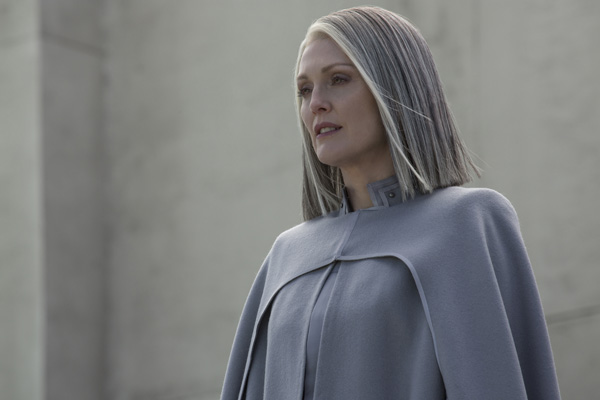2018 School Spending Survey Report
Flame Out | "The Hunger Games: Mockingjay—Part 2" Movie Review
Katniss Everdeen brandishes her lethal bow and makes her final bow in the film finale of Suzanne Collins's "Hunger Games" trilogy.

Jennifer Lawrence as Katniss Everdeen Photo: Lionsgate/Murray Close
Katniss Everdeen brandishes her lethal bow and takes her final bow in the film finale of Suzanne Collins's "Hunger Games" trilogy. Earlier in the series, Katniss earned the nickname "the Girl on Fire," as the victor of the blood-soaked winner-takes-all Hunger Games. Here, her flame flickers brightly at first, as she battles armies and dodges lethal booby traps (“pods”), until it peters out. The heroine goes out with a whimper in an unusually subdued conclusion for a film franchise that has kept the momentum going often at a roller-coaster pace. It's now all-out war. Will Katniss have the opportunity to assassinate the country of Panem's dictator, President Coriolanus Snow (the slithery Donald Sutherland), or will she be reined in by the coolly controlled Alma Coin (Julianne Moore), the leader of the rebellion? Or worse, will she be offed by her comrade-in-arms/love interest Peeta (Josh Hutcherson), brainwashed by Snow? Taken together, the movie quartet feels like one long film, even though the first one had a different director, Gary Ross, mainly because all share the same relentlessly somber tone. Once again, the filmmakers have faithfully tracked the twists and turns of Katniss's path, based on the road map provided by Collins's series closer, Mockingjay (Scholastic, 2010). As a result, her final installment has easily been divided into two films; there's plenty of plot to go around. However, the filmmakers add little from their own bag of tricks, although there's a lovely and evocative shot of Katniss standing alone in the foreground with her back to the audience as she watches everyone else at a wedding celebrate in the background. In only one sequence does director Francis Lawrence take a cue from a source outside of the Collins canon. As Katniss and her loyal cohorts make their way through an underground maze, the director turns the sequence into a classic Val Lewton beware-of-the-dark moment: the sole sound viewers hear is the splashing of sewage water. Visually, there's no light at the end of the tunnel. It's what you can't see that's frightening, even for readers who know what's coming to attack Katniss and her band of rebels: the scene is a nail-biter.
Julianne Moore as Alma Coin Photo: Lionsgate/Murray Close
With the exception of the portrait of Katniss, the other characters come across as thumbnails. Most don't have much time to make an impression before they are annihilated. (The films get an A for world-building, a B- for character development.) Virtually all of the dialogue originated in the book, whispered on screen and spoken at a measured pace. Noticeably, though, exchanges that ramp-up the sexual tension between Katniss and fellow hunter Gale (Liam Hemsworth) are absent. Humor is kept in its place and personal tensions on low. (Frivolous fashion plate Effie Trinket fleetingly flits about.) As a result, the direction allows little variation in star Jennifer Lawrence's performance. All the actors, with the exception of Sutherland and the fiery Jena Malone as the tortured Johanna, are slaves to the dystopian dread, and when Katniss relaxes her steely facade, she barely breaks into a Mona Lisa smile. Otherwise, she pretty much stays the same. True, she goes rogue, disobeying orders and setting out to kill Snow on her own, unless his forces kill her first, but Katniss has consistently been independent-minded. The bulk of her transformation from a poor 16-year-old girl from the sticks to the face of the rebel movement has taken place earlier in The Hunger Games (film and book), which had a tighter narrative. More so than the first three films, Mockingjay—Part 2 will almost strictly appeal to the books' fans and possibly alienate those who haven't touched the novels. The drawn-out ending will feel too slow and yet too clipped, with motivations left murky. (The script offers little in backstory or exposition.) As in the book, the film will come across as anticlimactic, with what feels like two endings. Nevertheless, no one can criticize the filmmakers for compromising the harsh worldview Collins has created. Directed by Francis Lawrence 136 min. Rated PG-13RELATED
RECOMMENDED
CAREERS
The job outlook in 2030: Librarians will be in demand
CAREERS
The job outlook in 2030: Librarians will be in demand
ALREADY A SUBSCRIBER? LOG IN
We are currently offering this content for free. Sign up now to activate your personal profile, where you can save articles for future viewing






Add Comment :-
Be the first reader to comment.
Comment Policy:
Comment should not be empty !!!